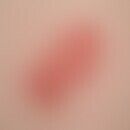Synonym(s)
DefinitionThis section has been translated automatically.
Psoriasis palmaris et plantaris, occupational dermatological aspects
The association between trauma and psoriasis was first described by Heinrich Köbner and is known as the Köbner phenomenon. The stimuli that occur can also be of an occupational nature and therefore have occupational dermatological relevance.
Indications of an occupational cause (varies according to Angelovska):
- First manifestation of palmoplantar psoriasis during occupational activity
- Localization of palmoplantar psoriasis on the body region whose work-related stress goes beyond an occasional cause.
- Demonstrable work-related stress (mechanical and/or chemical in nature, rarely microtraumas or contact sensitization)
- Improvement/healing when the occupational exposure is reduced (vacation/time off work)
- In the event of renewed work-related exposure, deterioration/recurrence in close temporal connection with the re-exposure
- Medically documented work exposure-congruent course of illness.
Evidence of occupational exacerbation (varies according to Angelovska):
- Psoriasis was already present at the start of the job
- The psoriasis objectively increases in intensity in a work-related, highly stressed localization while performing the occupational activity (worsening of psoriasis on the palms of the hands)
- There is demonstrable work-related stress (mechanical and/or irritative, rarely microtraumas or contact sensitization)
- Improvement of palmoplantar psoriasis when occupational exposure is reduced
- Worsening of palmoplantar psoriasis in close temporal connection with work-related exposure
- Medically documented occupational exposure-congruent course of disease.
Since psoriasis palmaris et plantaris is a congenital disease, the insured person is protected (analogous to atopic eczema) in "the condition he was in at the beginning of the harmful activity". This protection includes all predispositions, disease predispositions and constitutional weaknesses, i.e. also the genetic disposition for psoriasis. The causal factor "predisposition" is to be assessed here (as a partial cause) like any other factor.
In general, a distinction must be made between occupationally caused and occupationally aggravated psoriasis palmoplantaris. In the first case, the total damage must be compensated. In the second case, only the extent of damage that the damaging effect has added to the existing damage, i.e. the underlying condition.
As part of an assessment, it must be clarified whether the occupational activity is a significant partial cause or only an occasional cause alongside "other non-occupational trigger factors". An indication of "a significant partial cause" is the documented work-related worsening of the course of the disease on the palms of the hands (as areas of skin particularly exposed to occupational stress) as well as an improvement after a longer period of not working. In principle, it must be clarified and recorded in an expert opinion whether the extent and nature of the non-occupational strain does not even exceed the actual occupational strain and thus represents "the main cause". If the occupational activity is at least a significant partial cause (among other equivalent causes) for the triggering or maintenance of palmoplantar psoriasis, a BK 5101 is to be recognized in the sense of occupational causation, provided that the other requirements of BK 5101 are met.
LiteratureThis section has been translated automatically.
- Angelovska I et al. (2014) Palmoplantar Psoriasis in Working Life: A Case Series from the Practice in Consideration of the S1 Guideline for Occupational Dermatological Assessment of Psoriasis.JDDG 12:697-706
- Erlenkämper A (1998) Social law for physicians, Thieme Verlag , 206-231
- Schmidt A (1994) Atopy and expert opinion. Allergology 17: 94-96
Incoming links (2)
Occupational skin disease according to BK 5101; Psoriasis palmaris et plantaris (plaque type);Outgoing links (1)
Koebner phenomenon;Disclaimer
Please ask your physician for a reliable diagnosis. This website is only meant as a reference.



